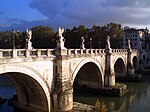Ponte Nomentano
Ponte Nomentano (Pons Lamentanus) | |
|---|---|
| File:RomaPonteNomentanoLatoValle.jpg The medieval bridge tower of the Ponte Nomentano resting on the ancient arch built of white travertine | |
| Coordinates | 41°56′01″N 12°31′57″E / 41.9336°N 12.5325°E |
| Carries | Via Nomentana |
| Crosses | Aniene |
| Locale | Rome, Italy |
| Characteristics | |
| Design | Fortified arch bridge |
| Material | Stone (incl. travertine), brick |
| Total length | 60 m |
| Width | 7.35 m |
| Longest span | 15 m |
| No. of spans | 3 |
| History | |
| Construction end | Probably 1st century BC |
| Location | |
 | |
The Ponte Nomentano (called Pons Lamentanus in the Middle Ages) is a Roman bridge in Rome, Italy, which carried the Via Nomentana over the Aniene (Template:Lang-la). Having lain outside the city limits for most of its history, the picturesque bridge is noted for its medieval bridge tower, which served to protect this important northern approach to Rome.
History
In antiquity, the Ponte Nomentano was located outside of the Aurelian Wall, at a distance of 3.9 km from the Porta Nomentana.[1] The East Roman historian Procopius records that the bridge was destroyed around 547 AD in the war for Italy by the Ostrogoths under their king Totila, but soon after rebuilt by the victorious Roman general Narses (in 552).[2] The still intact late Republican fabric of the main arch, however, indicates that the bridge could have been only partially damaged in the event.[3]
The lower part of the bridge tower dates, according to an unproven tradition, from the time of Pope Adrian I (772–795), while the imposing castle-like structure was constructed during a general overhaul of the bridge by Pope Nicholas V (1447–1455), after which minor repairs followed in 1461, 1470, and 1474.[1]
In 1849, the bridge was cut on a length of 7 m by French troops to check Garibaldi's advance on Rome, but it was immediately afterward restored.[4]
Today, the bridge is surrounded by a park, well within the municipal limits of Rome, and restricted to pedestrians.
Structure
The 31.30-meter-long superstructure of the Ponte Nomentano has, in essence, preserved its medieval character, while the dimensions of the bridge, which measure 60 m in overall length and 7.35 m in width, have remained practically unchanged since antiquity.[5] The 15-meter-wide central arch clearly dates back to ancient times, it is presumed from the late Republic or early Augustan Principate, as indicated by its semi-circular shape and the execution of the travertine stonework.[6] Apart from this, only some further layers of travertine in the retaining walls can be assigned with certainty to the Roman period.[6] The two lateral brick arches were built in the reign of Pope Innocent X (1644–1655) in lieu of stone vaults.[1]
Further examples for fortified bridges across the Aniene include the Roman Ponte Salario and Ponte Mammolo[7] and the medieval Ponte di San Francesco in Subiaco.
Gallery
-
Painting of the Ponte Nomentano around 1837 -
During 2008 flood -
Medieval bridge tower -
Passageway
References
- ^ a b c Galliazzo 1994, p. 37
- ^ Procopius: De Bello Gothico, 3.24
- ^ Galliazzo 1994, p. 37, 39
- ^ Galliazzo 1994, pp. 37–38
- ^ Galliazzo 1994, pp. 38–39
- ^ a b Galliazzo 1994, p. 39
- ^ O’Connor 1993, p. 68
Sources
- Galliazzo, Vittorio (1994), I ponti romani. Catalogo generale, vol. Vol. 2, Treviso: Edizioni Canova, pp. 37–39 (No. 21), ISBN 88-85066-66-6
{{citation}}:|volume=has extra text (help) - O’Connor, Colin (1993), Roman Bridges, Cambridge University Press, p. 68 (I15), ISBN 0-521-39326-4
See also
External links
![]() Media related to Ponte Nomentano at Wikimedia Commons
Media related to Ponte Nomentano at Wikimedia Commons
- Illustrated article at Romeartlover
- Ponte Nomentano at Structurae





